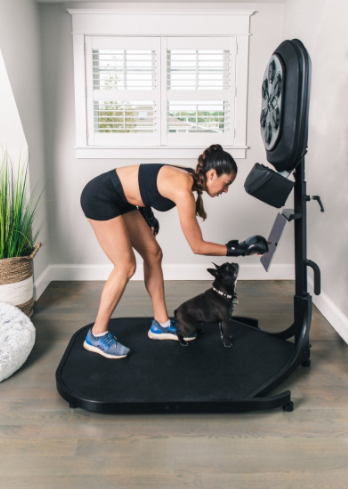To become a boxer, you must put out work, discipline, and self-confidence. If you’re serious about boxing as a career, you’ll want to join beginners boxing classes near me or a gym and hire a trainer. Beginners, on the other hand, can train themselves if they cannot afford to hire a trainer. A committed boxer should train for 3-5 hours, 3-5 times a week in general.
1. Develop Your Hands
Improve your punching technique to increase your punching power and endurance. Punches that are good are punches that convey power to your opponent with grace and ease. While speed and endurance should be worked on, superior technique will always result in a stronger boxer. Concentrate on the following points when performing the following drills:
- With your elbow, take the lead. Instead of using your wrist to strike your opponent, consider using your elbow.
- Maintaining a small footprint. You don’t want to flail around or move your body too much. Keep your non-punching hand close to your body and your legs firmly planted beneath you.
- Taking rests and allowing your arms to rest and move. Leave your arms slack, or “breathing,” while you’re not hitting, so they can rock easily with your body. Trying to clench and hold them rigidly will simply make you tired faster.
Concentrate on speed bag drills that are smooth and tidy. Speed bags are suspended from the ceiling and require you to create a strong and consistent punching rhythm. You strike in a regular, circular manner, moving your hands and the bag as you do so. This is one of the most effective techniques to improve your hand endurance, connection, and coordination.
- Run the speed bag for 3-5 3-minute intervals, with 30 seconds of break in between.
3-5 times every training session, hit the heavy bag for 3-minute intervals. The heavy bag (a large hanging bag used for punching) will become your best friend. You should punch it for 3-5 minutes, as if you were in a battle. Make certain, however, that you aren’t just standing there trying to hit. Stay on your toes, keep moving as if you were in a genuine fight, and pause every now and then to duck, dodge, and block as if you were in a real fight. In general, the closer you can get it to the genuine thing, the better the workout will be.
- Give the bag a swing before you start for a more challenging workout. You’ll have to concentrate on a moving target as a result of this.
To increase arm endurance, try 30-second punching sprints. Take 30 seconds to throw as many punches as you can with a heavy bag. When throwing punches, concentrate on speed rather than power. After 30 seconds, take a 30-second break before repeating 4-5 times more.
Start a strength-training program. To build muscle, you can lift weights or simply use your own body weight. Mix in 2-3 days of strength training every week, tapering down to one on fight weeks, no matter what your style is. Strength training should not be the focus of your workouts because boxing is such a muscle-intensive sport that you will gain strength every time you spar, fight, or shadowbox. To gain the most muscle in the shortest amount of time, focus on large, multi-muscle movements. The following are some useful workouts to try:
Body mass index: There are many of wonderful workouts to attempt if you can’t get to the gym, are under the age of 16, or simply don’t want to lift weights:
- Push-ups with a wide stance and a close-handed grip.
- Dips
- Planks should be done on the front and sides.
- Try inverted rows or body-weight rows.
- Pull-ups and chin-ups are two exercises that you can do.
Focus on a smooth, fluid approach when lifting weights. For the safest and best outcomes, you should move up and down with control.
- Standing and sitting rows
- Bench press is a form of resistance training.
- Flies and shoulder lifts
- Curls of the biceps
Slow sparring is a good idea. Slow sparring is a terrific tool for beginners because it brings all of your practice into the ring for a safe, technique-focused workout. It’s similar to conventional sparring with a partner, only you’ll be throwing punches at 75% of your normal speed. This is the ideal way to strengthen your opposite hand, focus on skills or maneuvers you haven’t mastered yet, and gain ring confidence. Because you must react to a live fighter, even if at a slow pace, this is an excellent approach to develop important abilities.
- Focus on coordination in all situations: follow through on your punches, keep your feet moving, and pay attention to hand location. Your entire body should be moving in unison with one another.
Training Your Feet (Method 2)
Interval exercise should be done twice a week. Long runs like those seen in Rocky aren’t really good boxing training. Interval training is the best approach to prepare for short, continuous bursts of high energy in boxing. When you do intervals, you alternate high-intensity, rapid sprints with short rest periods. As you get stronger, you can cut the rest times in half, increasing your gains even more.
- A 1-mile warm-up at a slow, easy jogging pace would be a decent first workout.
- 6 600m sprints, 1 minute rest between each. You should be running at about 75-80% of your maximum pace.
- End with a 5-mile slow, easy recovery jog.
On non-interval days, mix in lengthy runs, shadow boxing, and short sprints. Interval training will make up the majority of your cardio sessions, and it’s the most efficient approach to prepare for multiple intense rounds of boxing. On the other hand, you should still move your legs on non-working days. A combination of full-body training, longer, slower distance runs, and some light, rapid sprints is the best approach to achieve this. The activities listed below, which are used at US Olympic training camps, should be mixed and matched into a 30-minute workout:
- Warm-up run of 1-2 miles (moderate to fast pace).
- 1 round of shadowboxing (3-minute round).
- Run 200 meters backwards.
- 100 meter sprint
- For 400 meters, jog with your hands up, firing genuine punches.
To recover and stretch your legs, mix in 1-2 long, steady distance runs per week. The traditional morning run of 4-5 miles has a place in boxing beginner classes South Chicagoland training. It’s best to use it on days when you need to recover, such as after 2-3 days of heavy workouts. Longer, slower runs are also recommended in the days leading up to a bout, since you don’t want to be sore and exhausted when you enter the ring. Stretch before and after you run for 30 minutes to an hour at a pleasant, comfortable pace.
- Many trainers advise running first thing in the morning to allow time to replenish and recuperate before the skills workout.
- Maintain a defensive stance while jogging, periodically firing imitation punches to warm up your arms. Running is referred to as “roadwork” by most boxers.
Every day you train, jump rope. Jumping rope is one of the best boxing workouts you can do, since it improves your heart health, agility, timing, and coordination. Every workout should include 15 minutes of jumping rope. Begin by running in place, alternating your feet as you spin the rope. Alternate, more technical foot patterns as you improve:
- Jump with both feet at the same time.
- Make a cross with your hands. Cross your wrists across each other as the rope descends past your nose, then uncross them once the rope has passed your feet.
- As you jump, move your body. By hopping around as you leap, you can “walk” forwards, backwards, and side to side.
Agility training such as ladders and fast cuts should be practiced. Ladder drills are widely used in gyms around the world and may be readily incorporated into a number of workouts. Set up cones or a fitness ladder and concentrate on moving your feet swiftly through each spot. Mix up the routine by skipping every other foot, touching each space twice, working in and out of the ladder forward and backward, and so on as you go.
- Many sports use ladder workouts, and you should experiment with different motions on a regular basis.
Concentrate on proper footwork technique. It’s not just about working on your heart and lungs when it comes to having solid footwork. To improve as a boxer, you must train with proper form so that you do not have to worry about your feet during a battle.
- Focus on staying on the balls of your feet when practicing footwork. Right before your toes are the “knobs.” Pivoting, moving, and shifting become easier as a result.
- Maintain a straight spine. Avoid hunching or leaning back in your chair. This maintains an even center of gravity and allows for more fluid movement.
- Relax the muscles in your upper torso. You want your shoulders and pecs to be relaxed.
Method 3: Fight Preparation
Ensure that your diet consists solely of nutritious items. Proteins should be the foundation of your diet, and high-calorie meals such as fried foods, cakes, creams, butters, and sugars should be avoided. Every day, drink plenty of water. The more water you drink, the better for your body it will be. A good lunch might include the following items:
- Eggs, fish, and chicken are all good sources of lean protein.
- Unsaturated fats, such as those found in fish, avocados, and almonds.
- Instead of white rice, white bread, and other simple sweets, eat complex carbohydrates like pasta, whole wheat, and quinoa.
- Get some water if you’re thirsty at any time during the day. You’re well hydrated if you’re drinking to keep thirst at bay. When training, make sure you have plenty of water on hand.
In the ring, shadowbox by yourself. Shadowboxing Is a sport in which you move about the ring, throw punches, and imitate the pace of a genuine fight. This is the most effective approach to get into fighting form without risking injury or taking punches. You must, however, remain concentrated in order to get the most out of it. Keep your feet moving, alternate between punching and blocking, and maintain a high level of energy. Above all, ensure that each “bout” lasts the same amount of time as a conventional round — 3 minutes for amateur combatants.
- Concentrate on how you move around the ring. Move, dart, and dance to stay active.
- The mental aspect of shadowboxing is the most difficult. You must persuade yourself to practice with vigor or you will not get much benefit from it.
Pull-ups and chin-ups will help you build the back and arm power you’ll need for a good punch. Make sure you’re doing pull-ups even if you don’t do any other strength exercise. Perform a few each day, and gradually increase the number of repetitions. For the finest workout, use a slow, steady motion both up and down. While these will be challenging at first, try to start with at least 10 every day and gradually increase.
The grip and the muscles engaged in pull-ups and chin-ups are different.
- Pull-ups are performed with both palms facing away from you and hands shoulder-width apart. They target your back, shoulders, and core, with a particular emphasis on your back.
- Hands shoulder width apart, both palms facing you for chin-ups. They target your back, biceps, chest, and core, with a heavier emphasis on the chest and biceps.
Create a solid foundation. Your abs and obliques, which make up your core, are where you transmit energy from your upper to lower body. As a result, when practicing boxing, it should not be overlooked. Every day, work on your core by doing three sets of 20 reps of:
- The body is held in place. To protect your back, begin by sitting on your buttocks with your knees and feet in the air. For one exercise, place your palms under the floor, underneath your back, and curl your head up towards your knees.
- The planks (1-2 minutes each side, repeated 2-3 times)
- Leg raises
Keep a cautious eye on the other fighters. You can learn a lot from observing the greats in any sport. Make it a habit to watch bouts as part of your training. Spend each round of watching focusing on a different aspect of the game. Observe how they get out of difficulties, maneuver around the ring, and position themselves on offensive and defense in one round. Then keep an eye on their hands. How do they react and counter-attack on defense when they throw punches?
Find a sparring partner and practice once or twice a week. The only way to obtain realistic practice is to do so. You become accustomed to hitting and being hit by a moving opponent who, unlike a heavy bag, fights back. This is the time to receive a full-body exercise, practice new techniques, and improve your boxing skills. When it comes to training, there is no substitute for sparring.
- Only spar with a certified instructor under their supervision (and with their permission). You cannot spar safely unless you have an expert directing you and providing feedback after each round.
- Whenever possible, try sparring with superior boxers. They will challenge you to study more and help you develop as a fighter more quickly.
If you’re considering boxing as your new sport, hobby, or career this may be what you need to get started! If your already into the zone and you want to bring the zone home learn about How To Start Boxing At Home! Contact Legendary Boxing Training right away at (708)665-2623 for more tips on How To Start Training for boxing.




